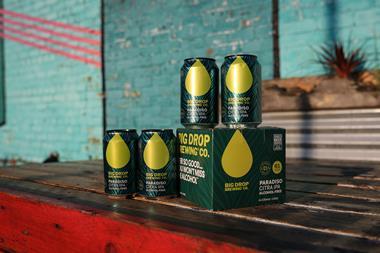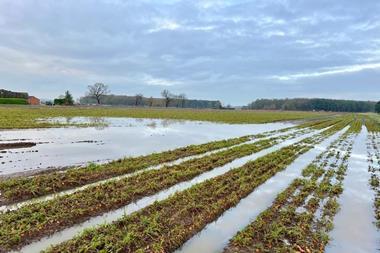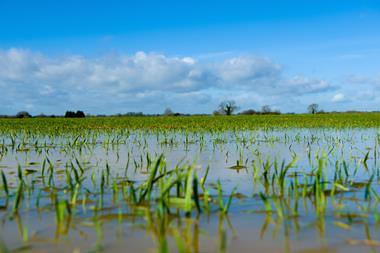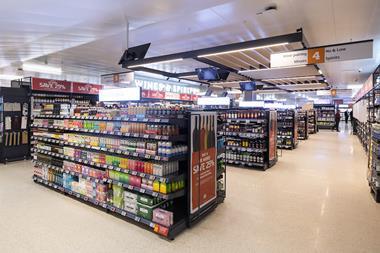English wine makers have grand ambitions – to increase output and steal 10% of the booming Champagne market in the next five years. Can they do it? Rob Brown
There’s a land grab taking place in the hills of southern England.
In the past seven years, England’s vineyards have grown 75% to more than 1,300 hectares in total and last year, production of English wine hit a record four million bottles for the first time [English Wine Producers].
The massive increase in output has been prompted by soaring demand both home and abroad for English wines sparkling wines in particular (see Product News, page 28). Domestic take-home sales of English wines have soared a whopping 77% to £32m over the past year in the UK alone [Kantar Worldpanel 52w/e 17 April 2011]. Business is so good that producers expect to be selling approximately six million bottles domestically by 2016, half of which will be sparkling that’s 10% of the Champagne market and 10 times the amount sold last year.
But don’t start popping the non-Champagne corks yet. Yes, demand is higher than it’s ever been in the wake of a raft of rave reviews and international wine awards and yes, there’s a fledgling export market still to exploit. But there’s a fine line between demand outstripping supply and vice versa and unless the industry sorts out its “terminally dreadful” brand building, as one expert puts it, there is a very real danger England’s grape expectations could be thwarted.
The total UK wine market is expected to remain flat over the next few years. Yet English vineyards are massively ramping up production of their pricey home-grown offerings in the hope that these will continue to buck the trend and maintain their impressive growth trajectory.
The UK’s largest wine estate, West Sussex’s Nyetimber, now boasts 438 acres and counting, and has recently forked out £25m on boosting capacity to a million bottles a year. Surrey estate Denbies plans to up annual output to 500,000 bottles in the next five years by expanding its vineyards 20% to 300 acres and increasing the amount of grapes it buys in. And Chapel Down is looking to add between 25 and 50 acres a year to its 100 acres of vines currently planted in the chalk hills of Kent.
It’s a calculated gamble to say the least, because cheap plonk this ain’t. English wines retail for anything from £7 to more than £30 a bottle and many of them are taking on wines produced by those at the very pinnacle of old world wine the Champagne houses.
But they’ve enjoyed some notable victories. Last year, Nyetimber, which has more than 65 awards to its name, saw off Champagne giants Bollinger and Louis Roederer when its Classic Cuvée 2003 was crowned Champion Worldwide Sparkling Wine. In May, Chapel Down’s Rosé Brut was the only wine of its kind to win gold at the International Wine Challenge. “Many in Champagne are quite concerned,” says Sam Lindo, winemaker at Cornwall’s Camel Valley Vineyard. “About 30 million bottles of Champagne are sold in England. Champagne’s market share is their for the taking.”
The attractions of the fizzy stuff are obvious. It’s the only part of the British take-home wine market showing any significant growth at present. Last year, Champagne sales grew 11.7% in volume, while Prosecco surged 50.4% [Kantar 52w/e 23 January 2011]. Conversely, the still market was flat, growing just 0.4%. If English wine is to really make a splash, however, it will need to seriously up its game in terms of branding and marketing.
“There could be a crisis on its way,” warns Nyetimber CEO, Eric Heerema, who fears that the huge increase in output by many winemakers could lead to a surplus in supply if it isn’t accompanied by adequate investment in brand building.
With English sparkling wines going for about £30 a bottle, effective branding is vital, agrees Chapel Down CEO Frazer Thompson. “There’s not much Champagne available at that price,” he says. “Sparkling is the most branded category so you’d better be sharp with your branding.”
Brands would do well to stop lazily aping the look of French or Italian counterparts, believe many experts. There also needs to be a dramatic improvement in the sector’s advertising and marketing tactics.
“Terminally dreadful,” is how one vineyard boss describes many of his competitors’ marketing. Others agree that to compete with the likes of Moët or Lanson, producers need to do far more to promote England as a credible producer of quality wine and to differentiate their offerings from budget British wines, which are made in the UK from imported grape juice and are also in growth (‘British Wine Sales Soar’, 11 June, p27).
Increasing the amount of wine made can only ever be part of the equation, says Julian Barnes, MD of Biddenden Vineyards, which in the past five years has doubled its output to circa 70,000 bottles a year. “Marketing is an important part of what we do,” he says. “You can’t just turn up with 20,000 bottles and hope to sell them all.”
A massive ad campaign isn’t a prerequisite. Even winemakers that don’t have lots of money to throw at marketing can create a buzz around their brands by supplying well respected restaurants or high-profile events. The key is to stimulate demand through word of mouth. It’s a trick Chapel Down has used to great effect. Its Rosé Brut was the fizz of choice at April’s Royal Wedding (and last week’s Grocer Gold Awards) and its Bacchus will feature on TV chef Richard Phillips’ menu at the British Golf Open next month.
Such events also raise the profile of English wines overseas. Although demand is growing, English wine has yet to register on the radars of many drinkers abroad. “People generally say that they didn’t know the English made wine and then say surely it isn’t any good,” says Paul Medder, senior project manager at Wine Intelligence.
Attitudes are changing. Chris White, MD of Denbies, is on the cusp of signing his first-ever major export deal with a Japanese retailer, which could see 20,000 bottles being shipped east every year. And that could be just the start. “They love British products out there,” says White. “We’ve never known demand like it.”
The other potential fly in the ointment is that perennial English problem the weather. Bad weather has wreaked havoc on estates in the west of England in recent years and neither Polgoon Wines nor Camel Valley, both based in Cornwall, have plans to expand production. Unlike their peers in the more clement lands of the East.
To ensure a sparkling future, they’ll need to do more than bolster output though. They’ll need to bolster their branding.
Tasting notes Making a gorgeous wine is only part of the battle. Selling it is almost as much of an art. But how does this new breed of English wine weigh up when it comes to pricing, presentation and of course taste compared with what the wine makers promise on their labels? We spoke to winemakers, retailers and wholesalers (and of course cracked a bottle or two open ourselves all in the line of duty of course) to get the measure of four of England’s most acclaimed sparkling wines.
Chapel Down Rosé Brut
Rsp: £24.99
Stockist: Majestic, Waitrose
They say: One hundred per cent Pinot Noir dry sparkling wine. The nose is subtle with a touch of strawberry and hints of cream and shortbread.
Cambridge Wine Merchants says: Very strawberries & cream. Slight residual sugars. Delicate, fun doesn’t take itself too seriously. People are comfortable spending this amount of money if it delivers on quality. This does.
We say: : Chapel Down has created a sophisticated brand image across it’s whole range. This fizz doesn’t disappoint either - delicate with no nasty surprises in the aftertaste.
Nyetimber Classic Cuvée 2006
Rsp: £27.99
Stockist: Ocado, Waitrose
They say: A warmer than average autumn in 2006 means the wine has a very strong fruit presence along with Nyetimber’s hallmark finesse and complexity.
Waitrose says: Made in true Champagne fashion. With a higher percentage of Chardonnay than the ‘05 vintage, this has a delicious creamy richness with notes of brioche, peaches and apricots with an elegant citrus twist.
We say: The label is as posh as its price tag. What’s inside is hard to fault. But with Champers so cheap today, have they done enough to differentiate it from the French fizz?
Denbies Greenfields 2006
Rsp: £22.99
Stockist: Ocado
They say: Bottle-fermented quality sparkling wine. Like all our wines, this is a limited release, produced only in the best of seasons using the finest of grapes.
Ocado says: Fresh taste with great aromas. Everything about this is great quality. We have really steady sales of our range of Denbies wines they’re up 55% year-on-year, which is obviously fantastic growth.
We say: Intense fruit. Our favourite. But that makes this bubbly’s branding doubly disappointing. It looks more like cheap own label Champagne than quality English wine.
Ridgeview Bloomsbury 2008
Rsp: £21.99
Stockists: Ocado
They say: Chardonnay dominance brings fruit freshness with great finesse the Pinots add depth and character. Sussex downs cellars says: Excellent quality, vibrant fruit, lots of fizz and high, youthful acidity. Currently our best selling English Fizz (helped by the fact that it is also our most local producer).
We say: Looks class. Tastes class. And Ridgeview struck marketing gold in May when this fizz was served to Barack Obama alongside some of the biggest names in Champagne at Buckingham Palace.
Nyetimber brews up new bubbly battle
The battle lines are being drawn. Nyetimber England’s largest wine estate is gearing up for its biggest-ever marketing push. And it’s clear who it has in its sights.
“We’re pointing directly at the Champagne market,” says Nyetimber CEO Eric Heerema. “We still have a lot of work to do on the brand so we’ll start an intensive marketing process next year. It’s going to be a cohesive approach focused at certain audiences.”
With a bottle of Nyetimber Classic Cuvée Vintage 2005 going for about £30 a pop, success will lie in winning over the well-heeled. The pressure is on for Nyetimber to cultivate that cachet. The winemaker has spent millions on upping production in recent years (capacity has risen from about 50,000 bottles to a maximum potential of one million a year) and it now has around half a million bottles maturing in its Sussex cellars.
Heerema is also eyeing the exports market. “We’re looking to start selling abroad but we won’t sell to just anybody. We’ll choose a few markets and commit to investing in building the brand.”









No comments yet